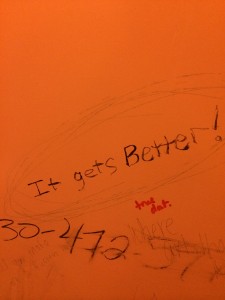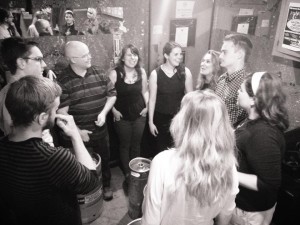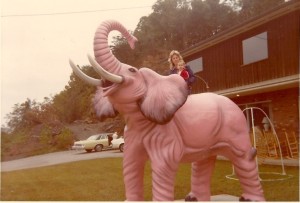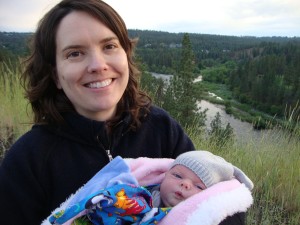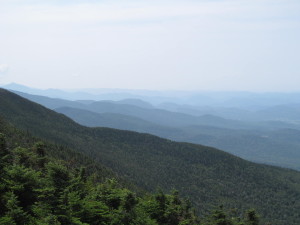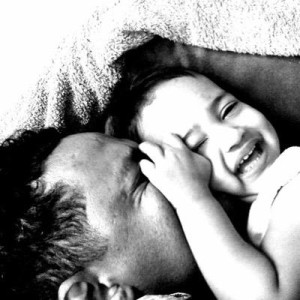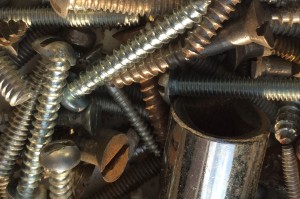 The garbage bags, smelling of beer and slimy with drops of liquid, are what I remember most.
The garbage bags, smelling of beer and slimy with drops of liquid, are what I remember most.
Before recycling was a thing, Dad, in his worn clothes and scruffy beard, bought aluminum cans for 10 cents a pound at the Farmer’s Market. I was his 5 year old helper.
The locals brought them in various containers–bags and beaten-up trash cans, old cardboard boxes and feed sacks. The cans would shift and jingle as they were weighed on a kitchen scale, rigged with a little platform. What my dad remembers most was getting smart—learning to watch for rocks in bags and cans loaded with dirt. Once he found a half-eaten turkey adding extra weight to a bag.
When there weren’t customers, our old blue Ford got loaded with the purchased metal. As the Market was winding down, we would make home visits, picking up loads from around town.
My dad engineered 6-foot extensions to the sidewalls of the truck, a cage of sorts made of scrap lumber and chicken wire. On the drive home, with the back of the truck full of aluminum, we wouldn’t speak. My dad isn’t much of a talker. And, over the rumble of cans shifting and vibrating, we couldn’t hear one another anyway.
At home, the cans would be released from their temporary captivity and spill onto the ground. The tool wielded by my father crushed the cans flat. If he used the truck to crush them, we knew his back was acting up.
In addition to mighty tools, the little feet of my brother and I would stomp on the cans, trying to hit them just so. A can might curve perfectly around our little feet and our work would turn to play as we danced around in our shoes made of cans.
Newly compacted, the smashed cans were shoveled into reused bags and tied off. Once there was a full load, they would be sold in the city for 32 cents a pound. That small profit kept my family afloat while my dad recovered from a serious back injury.
It was a lean time—an in-between time where making ends meet was the adult focus. My grandma put $5 in her weekly letter; my mom used it to buy hamburger meat.
Because the ingredients were cheap and it was a recipe she had mastered, my mom made cinnamon rolls to sell in the park. With darkness still blanketing the house, the oven baked batch after batch of the sweet treat, my mom sacrificing sleep. Always attentive to the clock, she could time the last batch perfectly to arrive at the Farmer’s Market just as people started to show up.
The hot rolls, darkened with cinnamon and whitened with sugar frosting, would  moisten the plastic wrap. In the trip down the dirt road, the wrap would begin to creep up leaving the edges of the rolls exposed to flying critters. My job was to stretch the wrap back over the edges and keep an eye out for pesky flies.
moisten the plastic wrap. In the trip down the dirt road, the wrap would begin to creep up leaving the edges of the rolls exposed to flying critters. My job was to stretch the wrap back over the edges and keep an eye out for pesky flies.
$1.75 for 8 rolls, fresh from the oven. Some had raisins.
Once that first plateful sold, I’d be given money to go and buy a bean burro from a lady from church. She brought pre-made burritos wrapped in tin foil. I loved holding that warm burrito in my hands on those early mornings and running between the can station and the cinnamon roll table.
My mom hasn’t made cinnamon rolls in years. I bet she still could if she needed to.
But, since I can remember, my family has collected cans, eventually taking them into the new Recycling Center that opened in town.
The Recycling Center closed several weeks ago—the resale price of scrap metal wasn’t high enough to keep him in business.
The tides have changed for my parents. They can now afford organic grass-fed beef. But, they can’t bring themselves to throw the cans away.
And the bags of cans are piling up on the front porch.





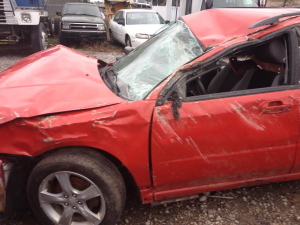

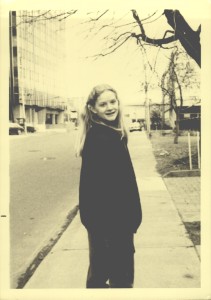


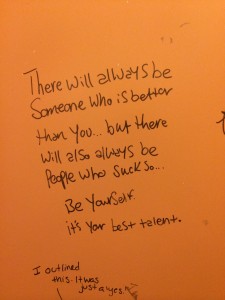 The iO building was located at 3541 North Clark, kitty-corner from Wrigley Field. It was not the ideal place for a theater. To get there, I nudged my way through Chicago Cubs foot traffic and mobs of bros who reminded me of my ex-boyfriend. I’d snake between cooing street vendors offering tickets from their back pockets and water bottles from blue coolers.
The iO building was located at 3541 North Clark, kitty-corner from Wrigley Field. It was not the ideal place for a theater. To get there, I nudged my way through Chicago Cubs foot traffic and mobs of bros who reminded me of my ex-boyfriend. I’d snake between cooing street vendors offering tickets from their back pockets and water bottles from blue coolers.